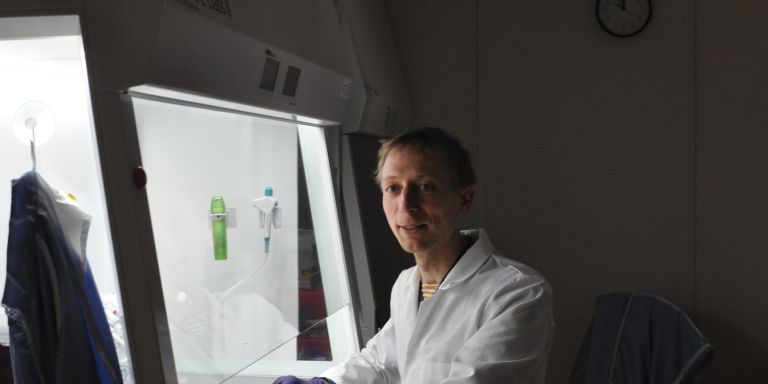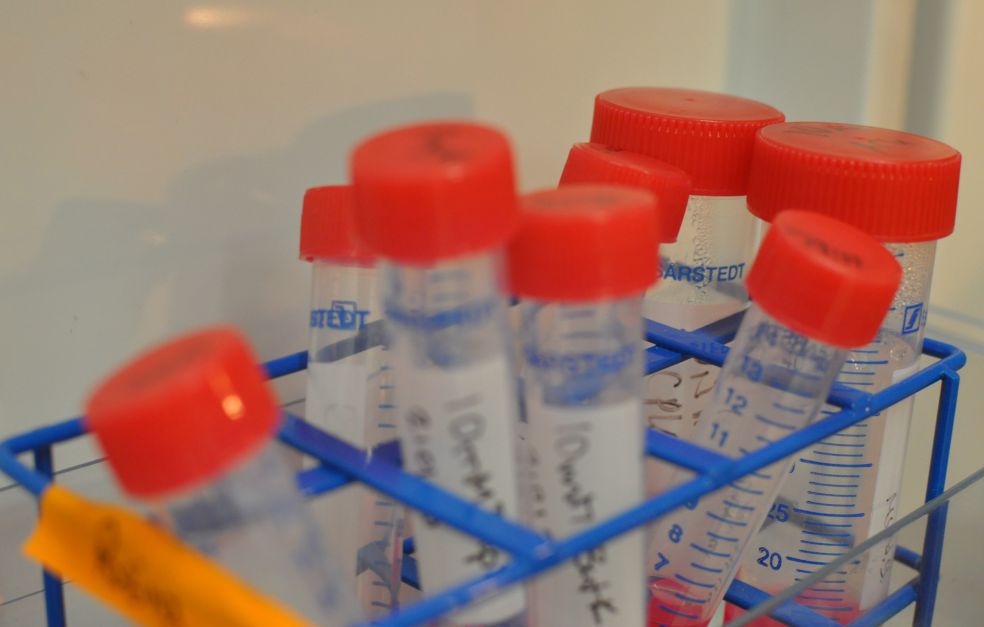Simon Elsässer has developed a new strategy for studying processes in living cells. One fundamental question is how cells can remember their own identity. Improving our knowledge of how cells inherit epigenetic information is of great importance in several contexts, including our understanding of what causes cancer.
Simon Elsässer
PhD in Biochemistry
Wallenberg Academy Fellow, Prolongation grant 2024
Institution:
Karolinska Institutet
Research field:
Biochemistry in the living cell. New synthetic and biological methods of studying and understanding protein functions in the living cell.
Even as a child in southern Germany, Elsässer wanted to be a researcher or an inventor. He was interested in science, particularly chemistry, and was inspired by his teachers. He chose to pursue a career in research, a decision that has taken him to institutions in Germany, the U.K. and the U.S. He has been based at Karolinska Institutet in Solna, just north of Stockholm, since 2015, and heads his own research team.
“It’s a privilege to be engaged in basic research, and to have the opportunity to ask fundamental questions about how the human body works. I’m driven by a desire to find out more about fundamental cell mechanisms – knowledge I believe can help us to understand what causes diseases of various kinds.”
Cells are the smallest living building blocks of the body, and consist of many parts. The traditional approach in biochemistry has been to address biological questions by taking apart the parts of the cell to study molecular details in an isolated and controlled environment. But then there is a risk of missing the incredible complexity that exist only in the living cell.
“Molecular research inside the living cell is important to gain a greater understanding of the whole machinery.”
New methods of exploring inside the cell
Elsässer has spent some years developing new technology and better methods of conducting a very thorough examination of how proteins work in a living cell. The result is a synthetic biological strategy offering new potential for precise and quantitative measurements in the cell environment. It is possible to select groups of proteins to examine them specifically, and protein behavior can be monitored over time.
The strategy includes new tools for modifying and designing proteins, and studying what happens when the protein dynamics in the cell are subjected to various changes, or “perturbations”, in a controlled way.
The new strategy can be applied to different research topics. Elsässer has chosen to focus on epigenetics, a system in the body that determines which genes are switched on and which remain inactive.
Epigenetics governs cell memory
All cells in a given organism carry the same DNA. DNA may be likened to a piano, where each key represents a gene that controls the cells. The piano always has the same keys, but different tunes can be played on it. Only the keys that are depressed make a sound.
In our metaphor, epigenetics is represented by the pianist who depresses the keys. The pianist decides whether we will listen to Beethoven or Elton John – or whether muscle cells or skin cells will be formed.
“Epigenetics is a term used in different ways, but in my research it’s about the way cells remember the past. It is an absolutely fundamental feature of the cell mechanism that it can remember previous signals and reprise its earlier actions in a stable and long-term program.”
When the cell divides, the epigenetic information is also shared. A skin cell remembers it is a skin cell; a muscle cell remembers it is a muscle cell. But Elsässer wants to ascertain exactly how that information is transferred, and how it is able to survive multiple cell divisions.
It used to be thought that the explanation was simple, that the epigenetic information was simply replicated during cell division, leaving a stable epigenetic imprint – but new findings show that the information transfer is more dynamic.
“We have now discovered that signals considered essential for retention of an epigenetic memory are very short-lived – these imprints only last for a few hours. This means that gene expression long-term memory relies on complex interactions. Some of these are fleeting; others operate for longer. But only together are they able to create a stable memory.”
“It is an honor to be chosen as a Wallenberg Academy Fellow. As a researcher from Germany, I feel it is extra valuable to be involved in a program helping to create a network and a community among other researchers in Sweden. The Wallenberg Academy Fellow program provides long-term support and enables me to focus on a challenging project for several years.”
New knowledge on the riddle of cancer
Ultimately, Elsässer hopes that his research will aid our understanding of human diseases. The epigenetic machinery regulates genes of all types, including those with a role in causing cancer.
A number of cancer mutations are associated with the very protein complex he is studying – the “polycomb” group. A better understanding of how the mechanism normally works may provide new answers to the question of what happens when a cell malfunctions and a tumor starts to grow. It is currently possible to study these malfunctions retrospectively by examining the cancer mutation, but not to see what happened before the mutation.
“We hope to delve into the mysterious causes of cancer with this new approach, especially as we now know more about which protein regions are associated with disease.”
The new technique enables the researchers to change patterns in the epigenetic network. They can, for instance, modify proteins by building small molecular tags into a protein that inactivates genes, so that the inactivated genes can later be identified.
“To enhance our understanding, we can remove or add a component and see how the network reacts to the disruption. And the great advantage is that we can now do this in a living cell – a system as complicated as this can’t be recreated outside the cell.”
Text Nils Johan Tjärnlund
Translation Maxwell Arding
Photo Birthe Meineke, Niklas Norberg Wirtén






